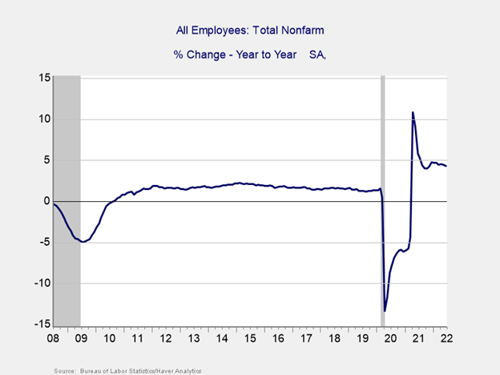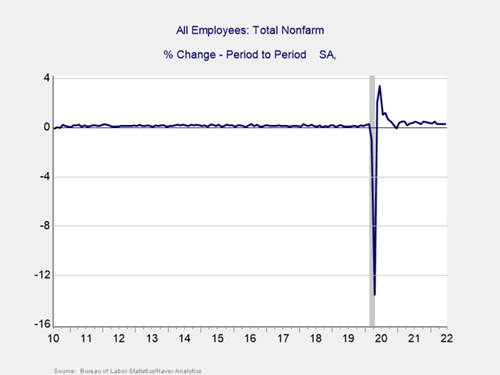 My colleague Sam Millette, manager, fixed income on Commonwealth’s Investment Management and Research team, has helped me put together this month’s Economic Risk Factor Update. Thanks for the assist, Sam!
My colleague Sam Millette, manager, fixed income on Commonwealth’s Investment Management and Research team, has helped me put together this month’s Economic Risk Factor Update. Thanks for the assist, Sam!
The reports released in July largely showed continued economic growth during the month. The July employment report indicated that the pace of hiring accelerated, which was an encouraging sign that the labor market remains healthy despite headwinds created by high levels of inflation throughout the economy. We also saw improvements in service sector confidence, but consumer confidence continued to decline and now sits at historically concerning levels.
Despite the continued economic growth, high levels of inflation, the Fed’s plans for tighter monetary policy, and the uncertainty caused by geopolitical and health risks remain. We have left the overall risk level at a yellow light for now.
The Service Sector

Signal: Yellow light
Service sector confidence increased by more than expected in July, as the ISM Services index rose from 55.3 in June to 56.7 in July against calls for a decline to 53.5. The larger-than-expected rise in service sector confidence brought the index to a three-month high, supported by improved new order growth and business activity during the month.
This is a diffusion index where values above 50 indicate growth, so this result signals continued expansion despite the decline in the index. As you can see in the chart above, service sector confidence remains well above the lows from initial lockdowns and near pre-pandemic levels, but it is down notably from the highs we saw late last year.
While confidence remains in expansionary territory, the recent relative weakness of the index compared to last year is a potential cause for concern and highlights the challenges businesses are facing. Given that the index remained well below the recent highs, we have left this indicator at a yellow light for now.
Private Employment: Annual Change


Signal: Green light
July’s employment report showed that 528,000 jobs were added during the month, which was better than the 250,000 jobs that were projected and the upwardly revised 398,000 jobs that were added in June. The better-than-expected July result marks 19 consecutive months with strong job growth and indicates that the labor market remains strong despite headwinds created by higher employment costs and labor shortages.
The underlying data was also encouraging. The unemployment rate fell to 3.5 percent in July, which is tied to the lowest unemployment rate since February 2020. Given the better-than-expected job growth in July and the strong underlying data, we have left this indicator at a green light for now.
Yield Curve (10-Year Minus 3-Month Treasury Rates)

Signal: Yellow light
The yield curve continued to flatten notably in July. This result was caused by rising short-term interest rates and falling long-term rates during the month. The 3-month Treasury yield increased from 1.72 percent at the end of June to 2.41 percent at the end of July. The 10-year Treasury yield, on the other hand, dropped from 2.98 percent at the end of June to 2.67 percent at the end of July.
The rise in short-term yields was primarily due to tighter monetary policy from the Fed due to high levels of inflation. The Fed has hiked the federal funds rate by 225 bps so far this year, and economists expect to see the Fed focused on combating inflation in 2022. This could lead to further rate hikes as the central bank tries to normalize monetary policy to combat rising prices.
While the spread between the 3-month and 10-year Treasury rates remains outside of the historical inversion danger zone, we have seen the yield curve flatten notably over the past two months, and we are now approaching inversion territory. Therefore, we have downgraded this indicator to a yellow light for now.
Consumer Confidence: Annual Change

Signal: Red light
Consumer confidence fell by more than expected in July, as the index dropped from a downwardly revised 98.4 in June to 95.7 in July against calls for a more modest decline to 97. On a year-over-year basis, confidence dropped by 23.5 percent in July, marking five consecutive months with year-over-year declines in confidence.
Historically, declines in confidence of 20 percent or more during the past year are a signal of a potential recession, and the July result is a concerning development following the weak results in June. This now marks two consecutive months with declines of 20 percent or more.
Given the fact that confidence continued to decline on a year-over-year basis in July and sits at historically concerning levels, we have left this indicator at a red light for now.
Conclusion: Economy Grows Despite Headwinds
The data releases in July continued to show signs of economic growth despite inflation concerns and tighter monetary policy. Looking forward, further economic growth remains the most likely path forward; however, as we’ve seen throughout the pandemic and the first half of the year, there are real risks that remain in this outlook.
The strong hiring growth during the month was an encouraging development, as the job market continues to signal a relatively healthy economy. The decline in consumer confidence was concerning, although it was partially offset by the improvement in service sector confidence. While declining consumer confidence has not yet caused consumer spending to decline notably this year, we may see slower spending growth until confidence improves. Ultimately, the pace and path of the expected recovery in the short term remain uncertain, and caution is still warranted.
We have left the overall economic risk indicator at a yellow light to reflect continued uncertainty and the potential for new setbacks in the months ahead.



 Print
Print

